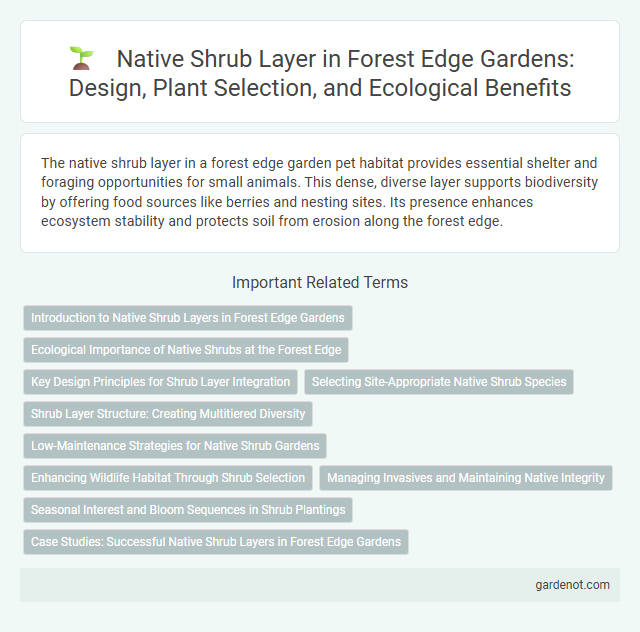The native shrub layer in a forest edge garden pet habitat provides essential shelter and foraging opportunities for small animals. This dense, diverse layer supports biodiversity by offering food sources like berries and nesting sites. Its presence enhances ecosystem stability and protects soil from erosion along the forest edge.
Introduction to Native Shrub Layers in Forest Edge Gardens
Native shrub layers in forest edge gardens enhance biodiversity by establishing a mid-story habitat that supports nesting birds, pollinators, and small mammals. These layers typically include species such as spicebush (Lindera benzoin), elderberry (Sambucus canadensis), and blueberry (Vaccinium spp.), which provide seasonal food sources and shelter. Incorporating native shrubs improves soil stability, conserves water, and aids in the natural succession process at the forest boundary.
Ecological Importance of Native Shrubs at the Forest Edge
Native shrubs at the forest edge play a vital role in enhancing biodiversity by providing essential habitat and food sources for local wildlife, including pollinators and bird species. These shrubs stabilize soil, reduce erosion, and act as a natural buffer against invasive species, promoting ecosystem resilience. Their deep root systems improve water infiltration and nutrient cycling, supporting overall forest health and edge ecosystem sustainability.
Key Design Principles for Shrub Layer Integration
In forest edge gardens, the native shrub layer enhances biodiversity by providing essential habitat and food sources for local wildlife. Key design principles prioritize selecting native species that thrive in partial shade and adapt to soil conditions, ensuring ecological harmony and resilience. Strategic spacing and layering promote healthy growth, prevent invasive species encroachment, and maintain the natural aesthetic of the forest edge.
Selecting Site-Appropriate Native Shrub Species
Selecting site-appropriate native shrub species for the forest edge garden enhances biodiversity and ecosystem resilience. Consider species such as Vaccinium corymbosum (highbush blueberry), Cornus sericea (red osier dogwood), and Rhododendron canadense (rhodora) that thrive in local soil and light conditions. Proper selection supports wildlife habitat, soil stabilization, and natural pest control within the shrub layer.
Shrub Layer Structure: Creating Multitiered Diversity
The native shrub layer in a forest edge garden establishes a crucial multitiered structure by incorporating diverse species with varying heights and densities, enhancing habitat complexity. This stratification supports a range of wildlife, promotes soil stabilization, and improves microclimate regulation through layered foliage. Effective shrub layer design combines native plants such as spicebush, serviceberry, and witch hazel to maximize ecological benefits and resilience.
Low-Maintenance Strategies for Native Shrub Gardens
Native shrub layers in forest edge gardens thrive with low-maintenance strategies such as selecting drought-tolerant species like spicebush and serviceberry that require minimal watering. Utilizing mulch to retain soil moisture and suppress weeds significantly reduces maintenance efforts. Incorporating native shrubs adapted to local soil conditions enhances resilience against pests and diseases, promoting sustainable growth.
Enhancing Wildlife Habitat Through Shrub Selection
Selecting native shrub species such as serviceberry, spicebush, and elderberry enhances wildlife habitat by providing essential food sources and shelter for birds, pollinators, and small mammals. These shrubs support biodiversity by offering nesting sites and seasonal fruits that sustain various species throughout the year. Incorporating a diverse native shrub layer stabilizes the ecosystem, promotes natural pest control, and improves soil health within the forest edge garden.
Managing Invasives and Maintaining Native Integrity
Effective management of invasive species is crucial to preserving the native shrub layer in forest edge gardens, as invasive plants can outcompete and displace indigenous flora. Regular monitoring and targeted removal of invasive shrubs like Japanese barberry and multiflora rose help maintain biodiversity and ecosystem balance. Promoting native species such as spicebush and witch hazel supports habitat integrity and enhances ecological resilience.
Seasonal Interest and Bloom Sequences in Shrub Plantings
Native shrub layers in forest edge gardens provide diverse seasonal interest through staggered bloom sequences that support local wildlife and enhance aesthetic appeal. Early spring-flowering species such as spicebush (Lindera benzoin) offer vital nectar sources, while summer blooms from mountain laurel (Kalmia latifolia) and winterberry holly (Ilex verticillata) extend visual interest into colder months. Effective layering of these shrubs ensures a dynamic garden environment with continuous color, texture, and habitat value throughout the year.
Case Studies: Successful Native Shrub Layers in Forest Edge Gardens
Case studies of successful native shrub layers in forest edge gardens highlight species such as Rhododendron maximum, Vaccinium corymbosum, and Ilex verticillata, which thrive in transitional zones. These native shrubs enhance biodiversity, support pollinators, and improve soil stability while creating a natural habitat for birds and small mammals. Strategic planting density and species selection based on local ecology ensure optimal growth and ecological benefits in forest edge environments.
Native shrub layer Infographic

 gardenot.com
gardenot.com